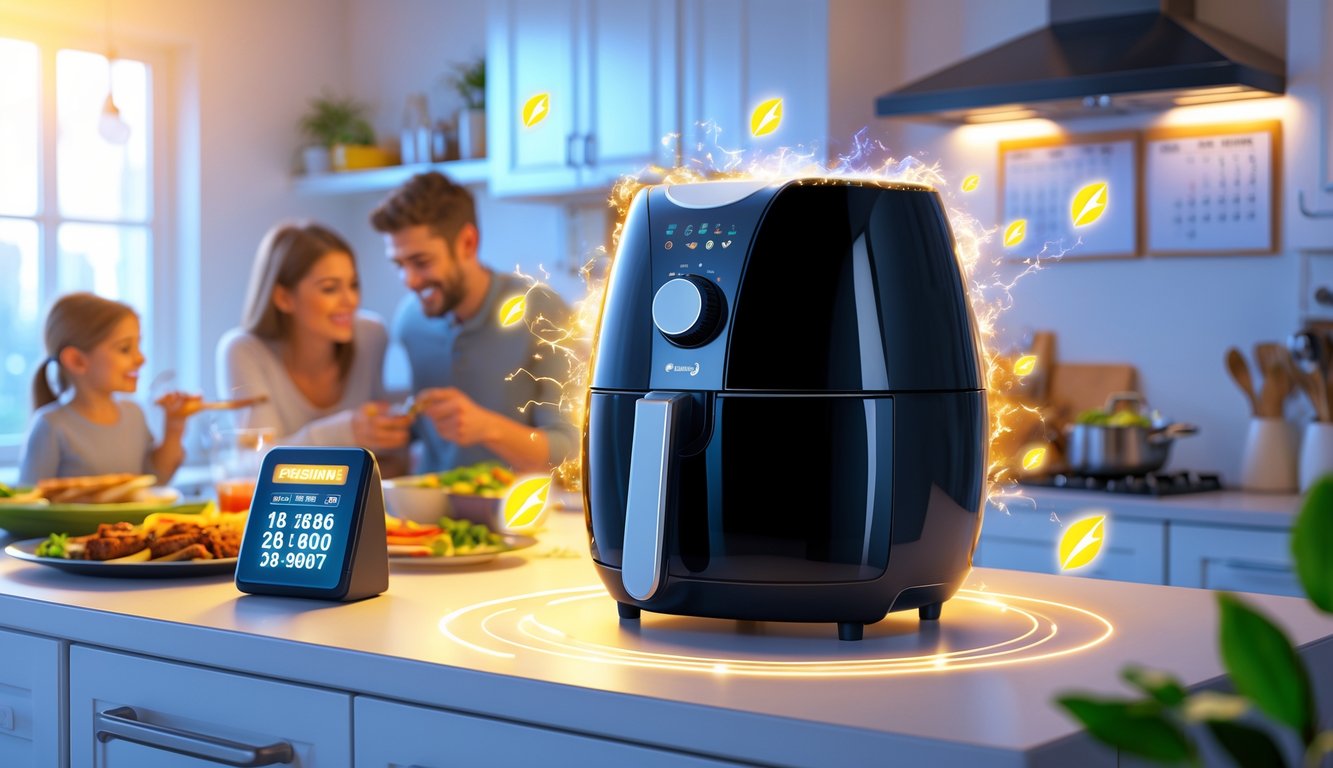
Comparing Air Fryers With Conventional Ovens
I try to defend my old-school oven, but the numbers keep making me look stupid. Ovens pull way more power, preheating eats up time, and the heat distribution? Sometimes it cooks my patience more than my food.
Energy Usage Differences
I keep checking my math because I don’t trust my bill. Standard ovens—especially electric ones—draw 2,000 to 5,000 watts, which is wild. Air fryers? Usually 1,400 to 2,100 watts (real-world numbers).
Roast veggies for 40 minutes in the oven, and it’s a marathon. Air fryer? Quick jog. Do that every night, and the savings add up. Even batch cooking in the oven doesn’t really help; you’re still heating up a giant metal box, not just a little basket (calculator).
Impact of Cooking Times and Preheating
Does anyone, ever, actually wait for the oven to preheat? (I do, but I hate it.) Ovens want 10-15 minutes, sometimes more if you get distracted. Air fryer? Throw the basket in and food’s sizzling in a couple minutes. Not magic, just less metal to heat.
Oven cooking times are a joke—chicken thighs that should take 25 minutes drag on because the temp wobbles. Air fryer? Consistent heat, no babysitting, no half-raw insides. Even consumer reports admit ovens run up your bill with all that preheating and slow cooking. Holiday baking? Don’t even ask.
Cooking Temperature and Heat Distribution
Even oven heat is a myth. My oven’s got hot and cold zones—no convection fan’s fixing that. Air fryer? Hot air from all sides, so fries and reheated pizza are always the same, at least. Not always better, but never worse.
The air fryer’s small size actually helps—food’s closer to the heating element and fan, so you don’t get those raw potato surprises. Getting a golden crust at a lower temp? Feels like cheating, but it isn’t. Try baking a cake in there, though, and good luck. For most stuff—chicken, veggies, leftovers—it’s just easier.
Oven doors leak heat every time you peek, and old ovens just blast it into the room. Air fryers vs. ovens on efficiency? Not even close if you’re paying the bill. Microwaves reheat coffee, sure, but try crisping a pizza crust—nope.
Smart Cooking Methods That Boost Savings
Halfway through the week, my energy bill spikes again. Aren’t these gadgets supposed to help? Only if you use them right—wrong size, too many batches, pointless preheating, or ignoring multi-basket options, and you’re back where you started. Here’s what actually works for me, and it’s not what the ads say.
Batch Cooking for Maximum Efficiency
By Wednesday, I always regret single-serving air fryer runs—should’ve loaded up more, but then I get nervous about soggy fries. Batch cooking’s the real move: one big go instead of three little ones, way less total cook time and energy. This isn’t subtle; family portions in a big 12-quart Chefman or something similar beat two or three rounds in a tiny basket.
Stacking food? Sometimes genius, sometimes a mess. Rotisserie chicken works in a bigger air fryer, but overloaded fries? Disaster. If I remember to shake the basket or rotate halfway, it’s better. Weirdly, preheating sometimes helps for thick proteins, not snacks. And batch cooking means fewer preheats, which actually saves power—even if the leftovers end up as dog food.
Choosing the Right Cooking Capacity
Ever try shoving twelve stuffed peppers into one of those dinky dual-basket air fryers? Don’t. It’s a nightmare. I mean, what was I thinking—double cook cycles, half the food cold, and me just standing there, wishing I’d read the specs instead of drooling over some promo shot with turkey legs. Turns out, matching the air fryer to what you actually cook is way more important than you’d think. If I’m honest, that 12-quart beast I almost bought would’ve just hogged my counter and collected dust. I cook for two, maybe twice a week? Overkill, plain and simple.
But go too small and you’re batch-cooking fries all night, wasting energy, and ending up with some soggy, some burnt. Those “multi-function” stickers? Mostly marketing—half the presets are useless. I just want the smallest machine that fits my regular meals. Anything bigger, and I’m paying for electricity I don’t need, and probably regretting it every time I move it to wipe crumbs. For the nerds: most models pull between 1.2 and 2.0 kWh per hour, so yeah, those little differences add up if you’re watching your bills.
Faster Cooking for Quick Meals
People keep saying air fryers are “instant.” I wish. My first “15-minute salmon” took 22 minutes—forgot to preheat, basket was overloaded, classic rookie mistake. Still, it’s not like the oven was any faster—waiting for that thing to preheat is torture, and the cook time? Forget it. At least with the air fryer, I eat sooner and use less power, so I’m calling it a win.
Honestly, the air circulation thing is real. Frozen potstickers, tilapia, whatever—I’m eating in way less time than with my oven. Maybe 20–40% faster, if I had to guess. Plus, I skip half the steps: no waiting, no oil puddles, no scraping pans. Sometimes switching between “bake” and “air fry” modes shaves off another couple minutes (and a few cents), but those random presets? I don’t trust them. Seriously, try both modes and see which works; there’s no magic setting, just trial and error.



